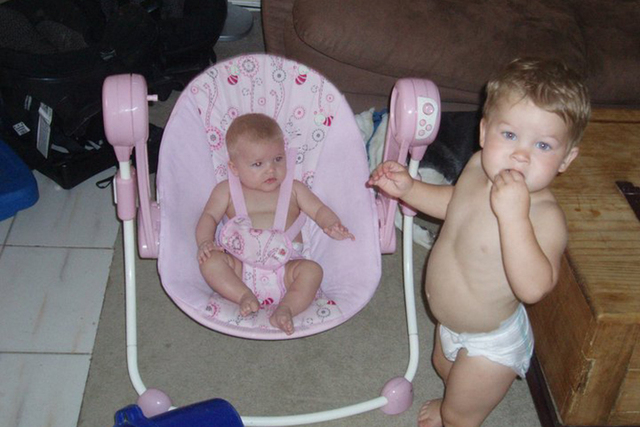Grandmother calls for changes to Clark County child abuse hotline
Before two of her grandchildren died while in the care of their meth-addicted mother, Mary Lafia made multiple calls to the Clark County Department of Family Services’ child abuse hotline.
Her son, Robert Lafia, is the father of Skylar Lafia, 2, and Aryana Lafia, 1, who died in a June 2012 trailer fire. Two-year-old David Gouailhardou also died in the blaze.
Earlier this month, Amy Hatzenpiller, 29, and Shane Gouailhardou, 25, each pleaded guilty to three counts of child abuse, neglect or endangerment with substantial bodily harm in connection with the fire at Van’s Trailer Oasis, 3610 Las Vegas Blvd. North, near Lamb Boulevard.
But the grandmother insists the county also bears a share of the blame.
“I’m angry with (Child Protective Services),” said Lafia, who questions why her reports of abuse and neglect didn’t prompt authorities to remove her grandchildren from a dangerous home. “My grandchildren died because they didn’t follow through.”
Lafia wasn’t alone in her concerns about the children. Amber Abbott, Lafia’s daughter and the children’s aunt, also contacted the hotline about Skylar and Aryana. The women say they called about 12 times from 2010 to April 2012.
They reported drug use, child neglect and domestic violence. They saw signs that Hatzenpiller was a meth user, which came out during her trial. Lafia and Abbott claim the system failed to intervene before the fire, despite the hotline calls they made to protect the children.
The women, who didn’t want to compromise the criminal case against Hatzenpiller and Gouailhardou, said they’re only now free to speak out. They publicly question how Family Services handled their hotline calls and also suggest that the agency received more calls about Skylar and Aryana than those disclosed on the child fatality report made to the state.
County spokesman Dan Kulin declined comment on the case, citing confidentiality laws and advice from the county’s attorney.
Lafia’s complaints aren’t the first to find fault with the responsiveness of the county hotline. In March, Clark County commissioners approved an $85,000 settlement in a lawsuit filed by the father of a 7-year-old boy who died at the hands of his mother and stepfather. Roderick “RJ” Arrington’s beating death came a day after a school worker called the hotline with concerns in November 2012. A hotline worker who took the call didn’t send a child welfare investigator to respond before the boy died, according to county and police records.
In the Lafia case, a written child fatality disclosure on the toddlers lists five prior reports — three for neglect and two for abuse — related to the children and their family from June 2005 to April 2012.
The final report alleged abuse, and was received on April 5, 2012. According to the fatality disclosure, a Family Services investigation determined the allegations were unfounded because the children were not in the care or custody of the alleged perpetrator. The case was closed on May 7, 2012, about a month before the fatal fire.
Lafia, a former Clark County School District elementary school teacher, was trained to recognize signs of abuse or neglect in children because teachers are mandatory reporters. But she said hotline workers on several occasions wouldn’t even take a report from her because she hadn’t witnessed the abuse or neglect.
“I’m not sure who answers the phone, but it needs to be someone who takes reports seriously,” said Lafia, who retired in 2010.
Lafia’s last call to the hotline was made around Easter 2012, when there was a domestic dispute in the children’s family. Abbott said she drove Hatzenpiller to a lab to take a drug test soon after that.
HOTLINE CALL DISCREPANCIES
Lafia and Abbott said this wasn’t Hatzenpiller’s first brush with child welfare — two other children were removed from her custody in Arizona. Grand jury testimony in her criminal case references another child and an Arizona connection.
“They were just young and full of life,” Lafia said of her grandchildren. “There was no reason for them to have lived like that or die like that.”
Lafia said she wants the way hotline calls are handled to improve to prevent similar tragedies. She may consider suing the county, but said she’s not interested in taking money from the agency. She just wants to see change.
“I assumed CPS was documenting my calls,” she said.
It’s unclear why the agency’s child fatality disclosure and the family differ on the number of hotline reports that were made in this case.
County officials refused to make a Family Services staffer available for an interview about hotline policies and procedures regarding responses to abuse and neglect allegations.
Asked about the conditions needed for a report, Kulin said, “You need to have a child, of course, and the allegations have to meet the definitions of abuse and neglect.” An “eligible perpetrator” with a presence in the child’s home also is needed, Kulin said.
Every report involving drug use or suspected use is unique and handled on a case-by-case basis, Kulin said.
When a call to the county’s child abuse hotline is deemed to warrant an investigation, it is assigned a code and priority designating when a response must happen. The highest priority calls get a response within three hours, midlevel calls get one within 24 hours, and the lowest priority calls get a response in 72 hours.
ADDITIONAL RED FLAGS
The calls from the grandmother and aunt aren’t the only reports flagging Hatzenpiller’s ability to care for children that were received by Family Services. In 2005, Hatzenpiller abandoned a child with a stranger and the agency opted not to take the 18-month-old girl into custody, according to grand jury testimony in Hatzenpiller’s case.
Betty Ross first met Hatzenpiller in a Las Vegas bar parking lot in December 2005. Hatzenpiller had a toddler with her and was in a dirty, rundown motor home with broken windows.
Ross took the toddler and mother to her home for showers and a fresh change of clothes that night. After showering, Hatzenpiller left the home, leaving her daughter behind and not telling Ross where she was going, according to Ross’ grand jury testimony.
The mother vanished as Ross tended to the child’s diaper rash, which covered her from head to toe. Ross called Child Protective Services and left a message shortly after that. A caseworker came the next day. By then, Ross and her family had started to like the child and wanted to care for her.
The caseworker gave her two choices, she said. Turn the baby over to them or keep her.
Child Protective Services said it “could leave the child with me and it would be on record that the child was there, that I had made the notification so I couldn’t go to jail for kidnapping,” Ross testified, according to court transcripts.
Ross cared for the child for weeks while contacting regulars at the bar and looking for the mother. But without the woman’s last name, Ross’ efforts turned up empty.
Weeks become months.
‘I HAVE NO KNOWLEDGE’
Eventually, Ross’ nephew and his wife took over care of the child. They were interested in adoption. Hatzenpiller visited once and left after seeing her child.
Around Christmas in 2006, police contacted Ross and said Hatzenpiller wanted her child back. A relative of Hatzenpiller was taking them to Arizona, and Ross’ family handed the child over.
Fast forward to 2012. By then, Family Services staff were being grilled about Hatzenpiller under oath before a grand jury.
Deva McTear, a Child Protective Services investigator, testified that a report of an abandoned child, under her agency’s policies, would be coded as an emergency.
But she also testified that the agency has no records showing that Ross called or that a caseworker visited. Asked why there was no documentation, she testified, “I have no knowledge.”
When the prosecution asked if that would not be in keeping with agency procedures, McTear responded: “Correct.”
Asked why Ross would have written notes that include her name, McTear said: “I do not know.”
She also testified that she never went to the Ross home and didn’t know anything about agency responses there.
Paula Hammack, assistant director for Family Services, also testified that there was no documentation showing a caseworker visited the Ross home in December 2005.
Prosecutors asked Hammack, who was a Child Protective Services supervisor in 2005, if she had any memory of the event or of her staff handling it. Her response: “No sir.”
Contact Ben Botkin at bbotkin@reviewjournal.com or 702-405-9781. Find him on Twitter: @BenBotkin1. Contact Yesenia Amaro at yamaro@reviewjournal.com or 702-383-0440. Find her on Twitter: @yeseniaamaro.


















